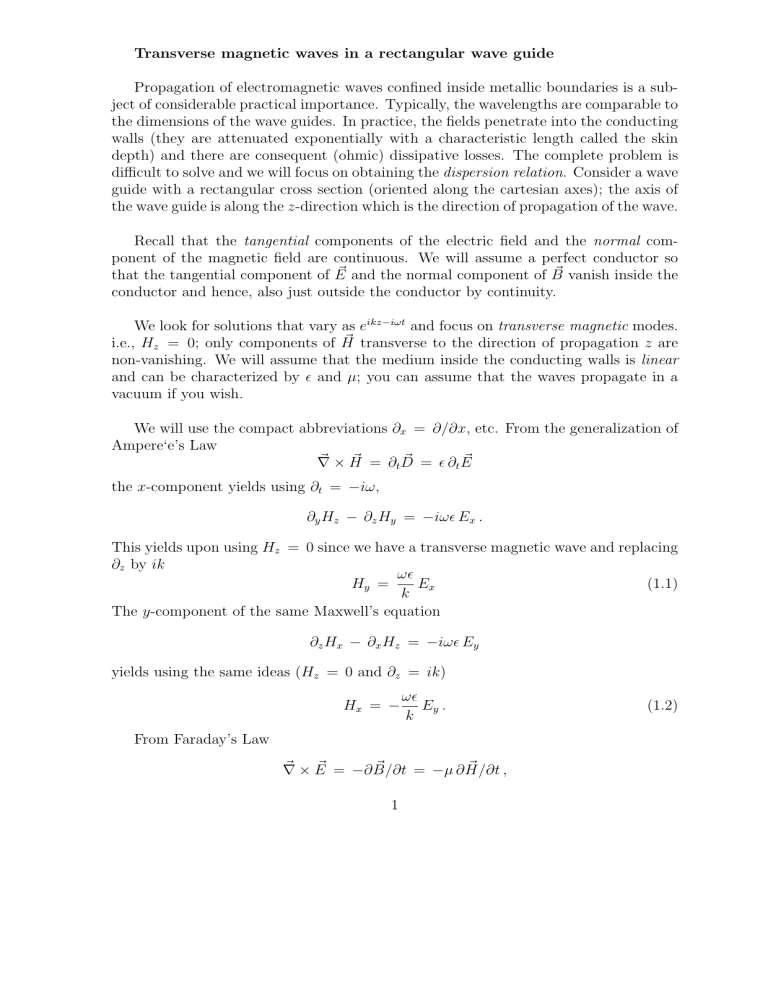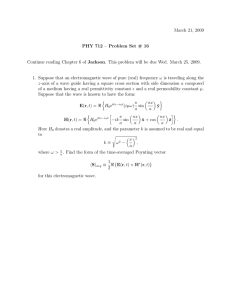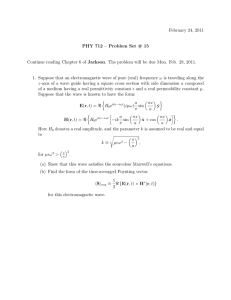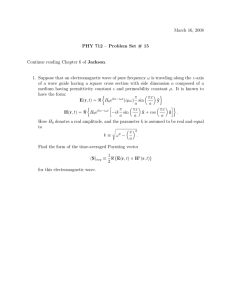Transverse magnetic waves in a rectangular wave guide
advertisement

Transverse magnetic waves in a rectangular wave guide Propagation of electromagnetic waves confined inside metallic boundaries is a subject of considerable practical importance. Typically, the wavelengths are comparable to the dimensions of the wave guides. In practice, the fields penetrate into the conducting walls (they are attenuated exponentially with a characteristic length called the skin depth) and there are consequent (ohmic) dissipative losses. The complete problem is difficult to solve and we will focus on obtaining the dispersion relation. Consider a wave guide with a rectangular cross section (oriented along the cartesian axes); the axis of the wave guide is along the z-direction which is the direction of propagation of the wave. Recall that the tangential components of the electric field and the normal component of the magnetic field are continuous. We will assume a perfect conductor so ~ and the normal component of B ~ vanish inside the that the tangential component of E conductor and hence, also just outside the conductor by continuity. We look for solutions that vary as eikz−iωt and focus on transverse magnetic modes. ~ transverse to the direction of propagation z are i.e., Hz = 0; only components of H non-vanishing. We will assume that the medium inside the conducting walls is linear and can be characterized by ² and µ; you can assume that the waves propagate in a vacuum if you wish. We will use the compact abbreviations ∂x = ∂/∂x, etc. From the generalization of Ampere‘e’s Law ~ ×H ~ = ∂t D ~ = ² ∂t E ~ ∇ the x-component yields using ∂t = −iω, ∂y Hz − ∂z Hy = −iω² Ex . This yields upon using Hz = 0 since we have a transverse magnetic wave and replacing ∂z by ik ω² Hy = Ex (1.1) k The y-component of the same Maxwell’s equation ∂z Hx − ∂x Hz = −iω² Ey yields using the same ideas (Hz = 0 and ∂z = ik) Hx = − ω² Ey . k From Faraday’s Law ~ ×E ~ = −∂ B/∂t ~ ~ ∇ = −µ ∂ H/∂t , 1 (1.2) we obtain for the x-component ∂y Ez − ∂z Ey = −µ∂t Hx . Now we use ∂t = −iω and substitute the expression for Hx from Equation(1.2) and find µ ¶ ω² ∂y Ez − ikEy = iµω − Ey . k This yields upon multiplying by ik and rearranging ik∂y Ez . µ²ω 2 − k 2 Ey = (1.3) Similarly, from the y-component we obtain from ∂z Ex − ∂x Ez = −∂t By = −µ ∂t Hy the relation ikEx − ∂x Ez = iωµHy and upon substituting for Hy from Equation(1.1) ikEx − ∂x Ez = i ω 2 ²µ Ex . k ik∂x Ez . (1.4) µ²ω 2 − k 2 Thus, we have shown that Ex , Ey , Hx , and Hy can be obtained from Ez which satisfies the wave equation with appropriate boundary conditions: Ex = (∂x2 + ∂y2 + ∂z2 ) Ez = µ² ∂t2 Ez (1.5) which can be written upon substituting the ansatz Ez (x, y, z, t) = E0 (x, y) eikz−iωt and cancelling the exponential factor as ∂x2 E0 + ∂y2 E0 − k 2 E0 = −µ²ω 2 E0 . So we have to solve the equation obeyed by E0 : " # ∂2 ∂2 + E0 (x, y) = −γ 2 E0 (x, y) ∂x2 ∂y 2 (1.6) where γ 2 ≡ µ²ω 2 − k 2 . Since the tangential component of the electric field has to vanish at the boundaries Ez must vanish at x = 0, a and y = 0, b at all times and therefore, we have µ E0 (x, y) = Emn mπx sin a 2 ¶ µ nπy sin b ¶ . (1.7) The differential equation yields − m2 π 2 a2 n2 π 2 − = −γ 2 = −(µ²ω 2 − k 2 ) . a2 b2 This gives rise to the dispersion relation m2 π 2 n2 π 2 ²µ ω = k + + 2 . a2 b 2 2 (1.8) Because of the sines instead of the cosines the lowest TM mode is (11). We assemble all the fields together apart from a factor of eikz−iωt : Hz = 0 Ez = E11 sin µ πx a ¶ µ sin µ ¶ πy b (1.9) ¶ (1.10) µ ¶ πy ik π πx sin cos 2 γ b a b ¶ µ ¶ µ ik π πy πx sin = E11 2 cos γ a a b ¶ µ ¶ µ iω² π πy πx = −E11 2 sin cos γ b a b µ ¶ µ ¶ πx πy iω² π = E11 2 cos sin γ a a b Ey = E11 (1.11) Ex (1.12) Hx Hy (1.13) (1.14) where the factors of i when they appear are interpreted as usual. The real part yields cos(kz − ωt) if there is no i and ∓ sin(kz − ωt) if one has ±i. Please check for signs or use them in the HW and blame them on me! 3




